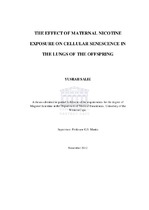| dc.description.abstract | Several studies conducted in laboratories at the University of the Western Cape has demonstrated an interference with the parenchymal lung tissue of the offspring when exposed to nicotine (smoking cigarettes and/or Nicotine Replacement Therapy [NRT]), maternally i.e. during gestation and lactation. This in turn, decreases the amount of air sacs (alveolar number) resulting in a reduced surface area available for efficient gas exchange in the offspring. Since the foetus and offspring are only exposed to nicotine during gestation and lactation, emphysema- like lesions appear to develop after nicotine withdrawal in the foetus. It has been proposed that during lung development in utero, a change in the "program" that controls the maintenance of lung integrity will occur in the long term due to the initial maternal nicotine exposure. Therefore, animals that were exposed to maternal nicotine resemble lungs that have undergone rapid, premature aging caused by cellular senescence. Furthermore, energy metabolism and structural changes in the glycolytic pathways appear irreversibly slower compared to animals that were not exposed to nicotine via the mother during gestation and lactation, resulting in a reduction in the anti-oxidant capacity of lung development. Previous studies have also shown that strong anti-oxidants supplemented by smoking mothers during gestation and lactation could possibly resist change in the "program" which controls lung development and integrity of the offspring in the long term. Lycopene – as a strong anti-oxidant supplementation have shown to decrease the alveolar volume and increase the alveolar surface area for better gas exchange after the offspring has been exposed to maternal nicotine. In this study I have treated pregnant wistar rats with nicotine, tomato juice (containing lycopene among other phytonutrients), and a combination of nicotine and tomato juice during gestation, to determine various changes in the lung structure and signs of premature aging in the lungs of the offspring. I have also performed various staining techniques such as H&E, connective tissue and β- galactosidase staining which indicated whether maternal nicotine exposure indeed induced premature cellular senescence in the lungs of the offspring. | en_US |

